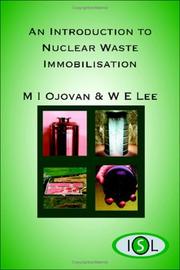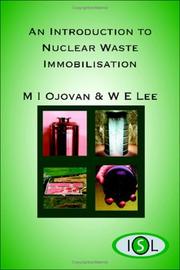| Listing 1 - 10 of 14 | << page >> |
Sort by
|
Book
ISBN: 1613447965 085709095X 1845696263 9781613447963 9780857090959 9781845696269 Year: 2011 Publisher: Oxford ; Philadelphia : Woodhead Pub. : Belgoprocess,
Abstract | Keywords | Export | Availability | Bookmark
 Loading...
Loading...Choose an application
- Reference Manager
- EndNote
- RefWorks (Direct export to RefWorks)
Radioactive wastes are generated from a wide range of sources, including the power industry, and medical and scientific research institutions, presenting a range of challenges in dealing with a diverse set of radionuclides of varying concentrations. Conditioning technologies are essential for the encapsulation and immobilisation of these radioactive wastes, forming the initial engineered barrier required for their transportation, storage and disposal. The need to ensure the long term performance of radioactive waste forms is a key driver of the development of advanced conditioning technologies
Radioactive waste disposal -- Evaluation. --- Radioactive waste disposal -- Handbooks, manuals, etc. --- Radioactive waste disposal. --- Radioactive waste disposal --- Civil & Environmental Engineering --- Engineering & Applied Sciences --- Environmental Engineering --- Radioactive waste canisters --- Equipment and supplies --- Nuclear waste disposal --- Nuclear engineering --- Radioactivity --- Refuse and refuse disposal --- Radioactive pollution --- Canisters, Radioactive waste --- Nuclear waste canisters --- Spent nuclear fuel canisters --- Spent reactor fuel canisters --- Waste canisters, Radioactive --- Containers --- Safety measures
Digital
ISBN: 9781613447963 1613447965 9780857090959 085709095X Year: 2011 Publisher: Philadelphia, PA Woodhead Pub
Abstract | Keywords | Export | Availability | Bookmark
 Loading...
Loading...Choose an application
- Reference Manager
- EndNote
- RefWorks (Direct export to RefWorks)
Radioactive wastes are generated from a wide range of sources, including the power industry, and medical and scientific research institutions, presenting a range of challenges in dealing with a diverse set of radionuclides of varying concentrations. Conditioning technologies are essential for the encapsulation and immobilisation of these radioactive wastes, forming the initial engineered barrier required for their transportation, storage and disposal. The need to ensure the long term performance of radioactive waste forms is a key driver of the development of advanced conditioning technologies. The Handbook of advanced radioactive waste conditioning technologies provides a comprehensive and systematic reference on the various options available and under development for the treatment and immobilisation of radioactive wastes. The book opens with an introductory chapter on radioactive waste characterisation and selection of conditioning technologies. Part one reviews the main radioactive waste treatment processes and conditioning technologies, including volume reduction techniques such as compaction, incineration and plasma treatment, as well as encapsulation methods such as cementation, calcination and vitrification. This coverage is extended in part two, with in-depth reviews of the development of advanced materials for radioactive waste conditioning, including geopolymers, glass and ceramic matrices for nuclear waste immobilisation, and waste packages and containers for disposal. Finally, part three reviews the long-term performance assessment and knowledge management techniques applicable to both spent nuclear fuels and solid radioactive waste forms. With its distinguished international team of contributors, the Handbook of advanced radioactive waste conditioning technologies is a standard reference for all radioactive waste management professionals, radiochemists, academics and researchers involved in the development of the nuclear fuel cycle. Provides a comprehensive and systematic reference on the various options available and under development for the treatment and immobilisation of radioactive wastesExplores radioactive waste characterisation and selection of conditioning technologies including the development of advanced materials for radioactive waste conditioningAssesses the main radioactive waste treatment processes and conditioning technologies, including volume reduction techniques such as compaction.
Book
ISBN: 3039218476 3039218468 Year: 2020 Publisher: MDPI - Multidisciplinary Digital Publishing Institute
Abstract | Keywords | Export | Availability | Bookmark
 Loading...
Loading...Choose an application
- Reference Manager
- EndNote
- RefWorks (Direct export to RefWorks)
The book outlines recent advances in nuclear wasteform materials including glasses, ceramics and cements and spent nuclear fuel. It focuses on durability aspects and contains data on performance of nuclear wasteforms as well as expected behavior in a disposal environment.
actinides --- corrosion --- modeling --- paper sludge ash --- americium --- geological repository --- seawater --- burnup credit --- spark plasma sintering --- glass composite materials --- spent nuclear fuel --- leaching processes --- zeolite polymer composite fiber --- crystalline ceramics --- glass --- lanthanum --- inorganic synthesis --- durability --- leaching --- layered double hydroxides LDH --- plutonium --- sedimentation --- conditioning --- criticality safety --- uranium --- radionuclide --- sintering --- vitrification --- rare earth elements --- loading curves --- silver iodide --- forward dissolution rate --- caesium phosphomolybdate --- waste form --- fractional release --- alkali borosilicate glass --- immobilisation --- iodine --- lesukite --- geopolymer --- radioactive cesium --- ceramics --- cesium adsorbed --- immobilization --- wasteforms --- secondary phases --- cesium --- safe storage --- borosilicate glass corrosion --- research reactor fuel element U3Si2-Al --- strontium --- in situ fluid-cell Raman spectroscopy --- magnesium potassium phosphate compound --- chlorine --- neodymium --- zirconium molybdate --- heavy ion irradiation --- nuclear waste --- microscopy --- hazardous water

ISBN: 1280632844 9786610632848 0080455719 0080444628 9780080455716 6610632847 9780080444628 Year: 2005 Publisher: Amsterdam ; Boston : Elsevier,
Abstract | Keywords | Export | Availability | Bookmark
 Loading...
Loading...Choose an application
- Reference Manager
- EndNote
- RefWorks (Direct export to RefWorks)
Safety and environmental impact is of uppermost concern when dealing with the movement and storage of nuclear waste. The 20 chapters in 'An Introduction to Nuclear Waste Immobilisation' cover all important aspects of immobilisation, from nuclear decay, to regulations, to new technologies and methods. Significant focus is given to the analysis of the various matrices used in transport: cement, bitumen and glass, with the greatest attention being given to glass. The last chapter concentrates on the performance assessment of each matrix, and on new developments of ceramics and glass composite m
Radioactive waste disposal. --- Radioactive waste disposal --- Safety measures. --- Nuclear waste disposal --- Nuclear engineering --- Radioactivity --- Refuse and refuse disposal --- Radioactive pollution --- Safety measures --- Engineering --- General and Others
Book
ISBN: 0080993923 9780080993928 9780080993935 0080993931 Year: 2014 Publisher: Kidlington, Oxford, U.K. Waltham, Mass. Elsevier
Abstract | Keywords | Export | Availability | Bookmark
 Loading...
Loading...Choose an application
- Reference Manager
- EndNote
- RefWorks (Direct export to RefWorks)
Book
ISBN: 0128183284 0128183292 9780128183298 9780128183281 Year: 2021 Publisher: Duxford, England ; Cambridge, Massachusetts ; Kidlington, Oxford : Woodhead Publishing,
Abstract | Keywords | Export | Availability | Bookmark
 Loading...
Loading...Choose an application
- Reference Manager
- EndNote
- RefWorks (Direct export to RefWorks)
Nuclear power plants --- Safety measures. --- Cement composites. --- Radioactive waste repositories --- Materials. --- Nuclear waste repositories --- Geological repositories --- Radioactive waste sites --- Radioactive waste disposal in the ground --- Cementitious composites --- Cement --- Composite materials
Digital
Abstract | Keywords | Export | Availability | Bookmark
 Loading...
Loading...Choose an application
- Reference Manager
- EndNote
- RefWorks (Direct export to RefWorks)
Drawing on the authors' extensive experience in the processing and disposal of waste, An Introduction to Nuclear Waste Immobilisation, Second Edition examines the gamut of nuclear waste issues from the natural level of radionuclides in the environment to geological disposal of waste-forms and their long-term behavior. It covers all-important aspects of processing and immobilization, including nuclear decay, regulations, new technologies and methods. Significant focus is given to the analysis of the various matrices used, especially cement and glass, with further discussion of other matrices such as bitumen. The final chapter concentrates on the performance assessment of immobilizing materials and safety of disposal, providing a full range of the resources needed to understand and correctly immobilize nuclear waste. The fully revised second edition focuses on core technologies and has an integrated approach to immobilization and hazards. Each chapter focuses on a different matrix used in nuclear waste immobilization: cement, bitumen, glass and new materialsKeeps the most important issues surrounding nuclear waste - such as treatment schemes and technologies and disposal - at the forefront.

ISBN: 9780080455716 0080455719 6610632847 9786610632848 9780080444628 0080444628 Year: 2005 Publisher: Boston Elsevier
Abstract | Keywords | Export | Availability | Bookmark
 Loading...
Loading...Choose an application
- Reference Manager
- EndNote
- RefWorks (Direct export to RefWorks)
Safety and environmental impact is of uppermost concern when dealing with the movement and storage of nuclear waste. The 20 chapters in 'An Introduction to Nuclear Waste Immobilisation' cover all important aspects of immobilisation, from nuclear decay, to regulations, to new technologies and methods. Significant focus is given to the analysis of the various matrices used in transport: cement, bitumen and glass, with the greatest attention being given to glass. The last chapter concentrates on the performance assessment of each matrix, and on new developments of ceramics and glass composite materials, thermochemical methods and in-situ metal matrix immobilisation. The book thoroughly covers all issues surrounding nuclear waste: from where to locate nuclear waste in the environment, through nuclear waste generation and sources, treatment schemes and technologies, immobilisation technologies and waste forms, disposal and long term behaviour. Particular attention is paid to internationally approved and worldwide-applied approaches and technologies. * Each chapter focuses on a different matrix used in nuclear waste immobilisation: Cement, bitumen, glass and new materials. * Keeps the most important issues surrounding nuclear waste - such as treatment schemes and technologies, and disposal - at the forefront.
Book
ISBN: 085709744X 0857094351 9780857097446 9780857094353 Year: 2013 Publisher: Philadelphia, PA
Abstract | Keywords | Export | Availability | Bookmark
 Loading...
Loading...Choose an application
- Reference Manager
- EndNote
- RefWorks (Direct export to RefWorks)
Radioactive waste management and contaminated site clean-up reviews radioactive waste management processes, technologies, and international experiences. Part one explores the fundamentals of radioactive waste including sources, characterisation, and processing strategies. International safety standards, risk assessment of radioactive wastes and remediation of contaminated sites and irradiated nuclear fuel management are also reviewed. Part two highlights the current international situation across Africa, Asia, Europe, and North America. The experience in Japan, with a specific chapter on Fukus
Hazardous waste site remediation -- Periodicals. --- Hazardous waste sites -- Periodicals. --- Hazardous wastes -- Management -- Periodicals. --- Radioactive waste sites -- Periodicals. --- Civil & Environmental Engineering --- Engineering & Applied Sciences --- Environmental Engineering --- Radioactive waste disposal. --- Nuclear waste disposal --- Nuclear engineering --- Radioactivity --- Refuse and refuse disposal --- Radioactive pollution --- Safety measures
Book
ISBN: 9780081027035 0081027036 0081027028 9780081027028 Year: 2019 Publisher: Amsterdam : Elsevier,
Abstract | Keywords | Export | Availability | Bookmark
 Loading...
Loading...Choose an application
- Reference Manager
- EndNote
- RefWorks (Direct export to RefWorks)
Radioactive waste disposal --- Management. --- Nuclear waste disposal --- Nuclear engineering --- Radioactivity --- Refuse and refuse disposal --- Radioactive pollution --- Safety measures --- Nuclear energy --- Environmental protection. Environmental technology --- materiaalkennis --- afvalverwerking --- kernenergie
| Listing 1 - 10 of 14 | << page >> |
Sort by
|

 Search
Search Feedback
Feedback About UniCat
About UniCat  Help
Help News
News